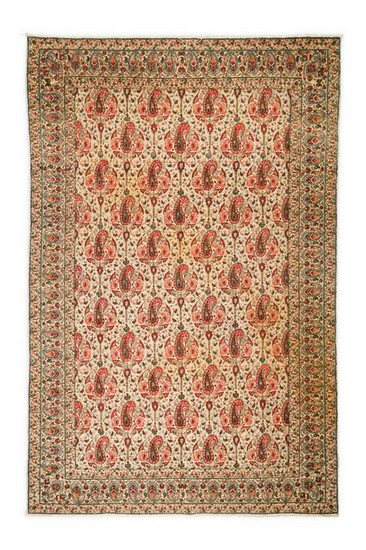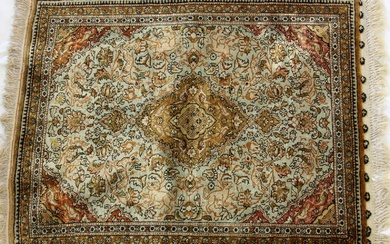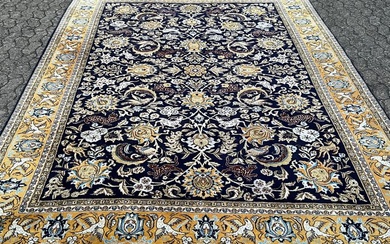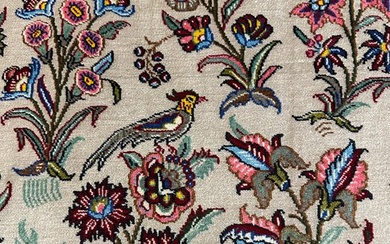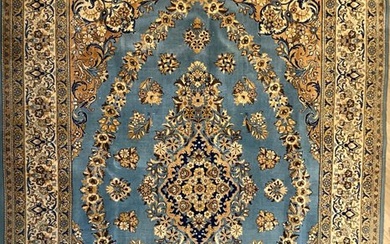Ghoum 195 X 133 cm
Origin :Â Central Persia
Size:Â 195 x 133 cm (Approximately 76.8 X 53.4 inch)
Age:Â 2nd quarter of 20th century
Knots: 6 x 6 = 36 knots per sq cm
Condition: Excellent
Description of Design and History:
Vintage Qum Rugs “ Located not far from Teheran, the city of Qum is a famous Persian pilgrimage city graced by impressive architectural monuments. But it does not, however, appear to have produced rugs before the 1920™s. Since that time though it has become known as a significant center for the manufacture of urban style rugs and carpets. The rugs of Qum tend to have allover repeat patterns of various type, especially botehs.
Qum weavers are also known for producing prayer rugs with elegant tree of life designs, as well as compartment designs derived from classical Persian garden carpets. Given their largely classical design repertory, Qum rugs tend to be finely woven with knot counts in the two hundreds and three hundreds. Forty to forty years ago Qum also became a production center for Persian all-silk rugs of exceptional fineness. Today weavings of Qum continue to be among the most respected and highly prized fine Persian rugs.
The production of Qum rugs began in the early decades of the 20th century. Qum vintage rugs are identified as such because of their historical association with the Islamic holy city of Qum, where they were originally woven. Qum itself an ancient and important city in central Persia, where it hosts a sizable permanent population in addition to a constant influx of pilgrims and other religious travelers. While vintage Qum rugs do not boast the ancient pedigree of Tabriz or Sultanabad rugs and carpets, these special and storied carpets represent a distinct style with a great deal of merit.
The Qum rugs themselves are made of a thin pile in silk and wool, as most Qum rugs are traditionally used as wall hangings. The fine materials with which Qum rugs are woven allow for weavers to draw exquisite, precise detail work throughout. Unlike traditional designs, fine Qum rugs generally feature small allover designs, and are considered an example of a city style. Vintage Persian Qum rugs are also often characterized by exceptional curve-linear lines. The color pallet most associated with Iranian Qum rugs consists of red, blue and ivory, although other colors are common as well. All natural dyes are paramount for the carpet to have more than just decorative value. Beyond that, various dyers had varying levels of skill and invested different lengths of time in dyeing the yarns. The Å“quality of color“its radiance and level of nuance within each color“is centrally important. Certain rare colors such as Tyrian purple, saffron yellow, cochineal rose and greens add to the carpetâ„¢s value
 Â
Condition Report: The absence of a condition report does not imply that the lot is in perfect condition. Please carefully read our terms of sale, shipping pick up & payment information. We are happy and willing to answer questions about any of our lots as well as to send additional images. It is the responsibility of the bidder to pose any questions BEFORE bidding. Please email us for a shipping quote if needed. All sales are final.
View it on
Estimate
Time, Location
Auction House
Origin :Â Central Persia
Size:Â 195 x 133 cm (Approximately 76.8 X 53.4 inch)
Age:Â 2nd quarter of 20th century
Knots: 6 x 6 = 36 knots per sq cm
Condition: Excellent
Description of Design and History:
Vintage Qum Rugs “ Located not far from Teheran, the city of Qum is a famous Persian pilgrimage city graced by impressive architectural monuments. But it does not, however, appear to have produced rugs before the 1920™s. Since that time though it has become known as a significant center for the manufacture of urban style rugs and carpets. The rugs of Qum tend to have allover repeat patterns of various type, especially botehs.
Qum weavers are also known for producing prayer rugs with elegant tree of life designs, as well as compartment designs derived from classical Persian garden carpets. Given their largely classical design repertory, Qum rugs tend to be finely woven with knot counts in the two hundreds and three hundreds. Forty to forty years ago Qum also became a production center for Persian all-silk rugs of exceptional fineness. Today weavings of Qum continue to be among the most respected and highly prized fine Persian rugs.
The production of Qum rugs began in the early decades of the 20th century. Qum vintage rugs are identified as such because of their historical association with the Islamic holy city of Qum, where they were originally woven. Qum itself an ancient and important city in central Persia, where it hosts a sizable permanent population in addition to a constant influx of pilgrims and other religious travelers. While vintage Qum rugs do not boast the ancient pedigree of Tabriz or Sultanabad rugs and carpets, these special and storied carpets represent a distinct style with a great deal of merit.
The Qum rugs themselves are made of a thin pile in silk and wool, as most Qum rugs are traditionally used as wall hangings. The fine materials with which Qum rugs are woven allow for weavers to draw exquisite, precise detail work throughout. Unlike traditional designs, fine Qum rugs generally feature small allover designs, and are considered an example of a city style. Vintage Persian Qum rugs are also often characterized by exceptional curve-linear lines. The color pallet most associated with Iranian Qum rugs consists of red, blue and ivory, although other colors are common as well. All natural dyes are paramount for the carpet to have more than just decorative value. Beyond that, various dyers had varying levels of skill and invested different lengths of time in dyeing the yarns. The Å“quality of color“its radiance and level of nuance within each color“is centrally important. Certain rare colors such as Tyrian purple, saffron yellow, cochineal rose and greens add to the carpetâ„¢s value
 Â
Condition Report: The absence of a condition report does not imply that the lot is in perfect condition. Please carefully read our terms of sale, shipping pick up & payment information. We are happy and willing to answer questions about any of our lots as well as to send additional images. It is the responsibility of the bidder to pose any questions BEFORE bidding. Please email us for a shipping quote if needed. All sales are final.
